An Inside Look at Crafting a Strong Nonprofit Marketing Plan

Your nonprofit needs compelling marketing to engage new and existing supporters to boost brand awareness, cultivate donors, motivate them to volunteer, and more. Many nonprofits across the country see great results from their marketing efforts. For example, the truth Initiative leverages a multi-step SMS, email, and social messaging campaign to spread awareness of—and stop—the sale of tobacco in Walgreens.
As a result, the advocacy campaign collected 5,300 youth names and rallied the support of more than 67,000 young people.
But what’s behind successful campaigns like these? In almost every case you’ll find the same answer: meticulous planning. A nonprofit marketing plan lays the roadwork your team must follow to achieve your goals. In this guide, we’ll explore everything you need to know about crafting a marketing plan:
- Nonprofit Marketing Plan FAQs
- Get Prepared and Dig Into Your Data
- How to Create the Core Elements of a Nonprofit Marketing Plan
- Get the Expertise and Experience of a Nonprofit Marketing Agency
Creating a nonprofit marketing plan is about setting your campaigns up for success, identifying and sticking to your goals, and aligning with your mission. But first, we’ll cover some marketing plan basics to make sure you have all the context you need to get started.
Want to build strategic, mission-aligned plans that drive fundraising success? Our experts will do it for you.
Nonprofit Marketing Plan FAQs
What is a marketing plan?
A nonprofit marketing plan is a detailed document that outlines your marketing campaign goals, how you plan to reach them, who is responsible for various tasks, what marketing channels you’ll use, and more.
Larger, multichannel campaigns can feel overwhelming, and it’s easy to stray from your initial goals. These plans, which summarize research about your target audience and center around your top objectives, can serve as an excellent source of truth throughout the campaigns.
Why does your nonprofit need a marketing plan?
As a busy nonprofit professional, you might be tempted to skip this step and start creating content for your marketing campaign. However, this would be like starting a road trip without a map. You could get lost, double your travel time, or arrive at the wrong destination.
So, while it might feel like you are saving time by launching the campaign immediately, your nonprofit could waste precious time and resources on ineffective marketing strategies. Some of the other advantages of a marketing plan include:
- Clear goals. You’ll need to set clear goals to build the rest of your marketing plan around. These goals should be broader, such as increasing awareness of your cause. Then, you’ll build out more granular objectives that relate to the broader goals—for instance, growing your social media following by 10%. Outlining your goals before executing the campaign ensures each action you take is directly related to a target that furthers your mission.
- Deep understanding of your audience. Take the time to research your audience before launching your campaigns. Include key findings and create audience personas (fictional people that embody your target audience). Like your goals, you can refer to these personas throughout the campaign to confirm that each marketing decision resonates with your core group of supporters.
- Cohesion across your team. When all of your campaign plans are summarized in one place, it’s easy for your staff members to get on the same page. For example, they can read the full marketing plan to understand how their responsibilities fit in with other roles and the broader goals of the campaign.
Working with a nonprofit marketing agency can take this step off your plate if your organization doesn’t have the bandwidth for detailed planning. Look for an agency that will collaborate with you, perform audience research, and has a robust portfolio of other successful campaigns.
What are the three pillars of nonprofit marketing?
Successful nonprofit marketing campaigns consider three key factors: the market, supporters, and available resources. As you plan your campaign, keep each of the three pillars in mind:
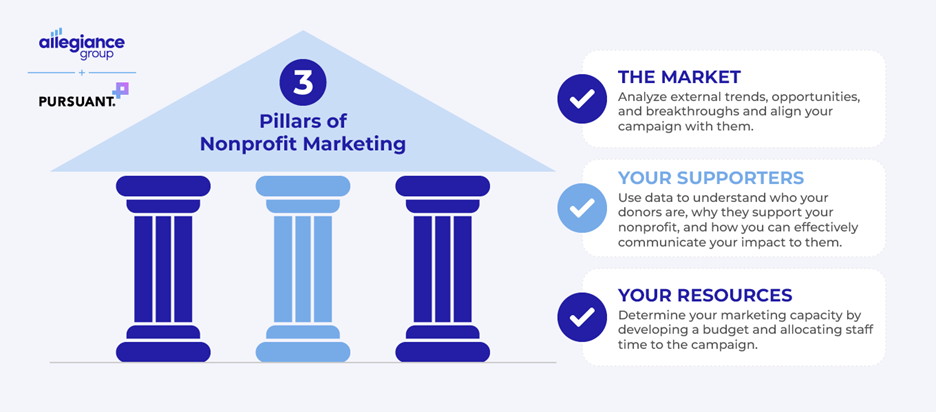
- The market. Your nonprofit doesn’t exist in a vacuum, so you’ll need to consider market trends when launching any campaign. For example, you may be more likely to see significant returns on your marketing investment during periods of economic growth.
- Your supporters. Who are your supporters, why do they support your nonprofit, and how are you communicating your impact with them?
- Your resources. Does your nonprofit have the capacity to reach its marketing objectives? Including a budget in your marketing plan should help answer this question.
Reflecting on these nonprofit marketing pillars, your mission, and your goals for the campaign will help you craft a plan that is detailed, realistic, and, above all, relevant to your organization and its supporters.
Get Prepared and Dig Into Your Data
Before you decide how to position your campaign or how much to spend on advertising, it’s critical to analyze your supporter data.
This data is the key to unlocking personalized experiences for your donors. Personalization has many benefits, from enhancing supporters’ experiences with your nonprofit to improving conversion rates and engagement. When you know that the strategies, messaging, and communication channels you’re using will catch supporters’ attention and inspire them to give, you can rest assured that you’ll see a return on your marketing investment.
To prepare for the planning stage, get to know your donors by:
- Using data analytics tools. These tools aggregate and organize information about your supporters, past campaigns, and the broader market. Ideally, they should also help you visualize and understand your data at a glance by providing customizable dashboards and graphs.
- Conducting user research. Collect the information you need about your audience to create effective content. You or your marketing agency may conduct interviews with target audience members, share surveys, create audience personas, perform A/B tests, and more.
- Performing audits. Fundraising audits help you identify organization-wide trends, pinpoint more granular opportunities for improvement, and strengthen the foundation of your marketing efforts. Consider auditing your digital campaigns to ensure you are accurately tracking key performance indicators (KPIs), properly managing your digital advertising accounts (e.g., Google Ads), and understanding tracked data.
While you can take care of these steps on your own, consider working with an expert to improve your results. At Allegiance Group + Pursuant, we combine our years of nonprofit marketing experience with thorough data analysis. Using the GivingDNA platform, we blend your files with third-party data to gain a comprehensive understanding of your supporters and give each one a relevant, rewarding experience.
We’re here to help you plan and execute effective marketing campaigns so you never miss another opportunity.
How to Create the Core Elements of a Nonprofit Marketing Plan
Your nonprofit marketing plan will be a multi-page document that anyone involved in the planning and execution of your marketing campaign can access. Typically, these documents are broken into several main sections. Here are each of the core elements and how to create each one:
Executive Summary
Positioned at the top of the marketing plan, this section provides a high-level overview of your campaign. In other words, it should simplify the complexities of your marketing campaign so readers can get an at-a-glance understanding from the first page. The section summarizes:
- Who your nonprofit is
- The causes you advocate for and those you serve
- The purpose of the campaign
- Who your audience is and how you’ll reach them
- The results of your research
- An overview of organizational and campaign goals
You can also include a brief list of team leaders or staff members who will be involved in the campaign and what their roles are (e.g., social media marketing director). This way, anyone reading the plan will know who to reach out to with questions or concerns.
Mission, Goals, and Values
List your nonprofit’s mission statement, values, and vision for the future. Your organization should already be using each of these to guide its decisions.
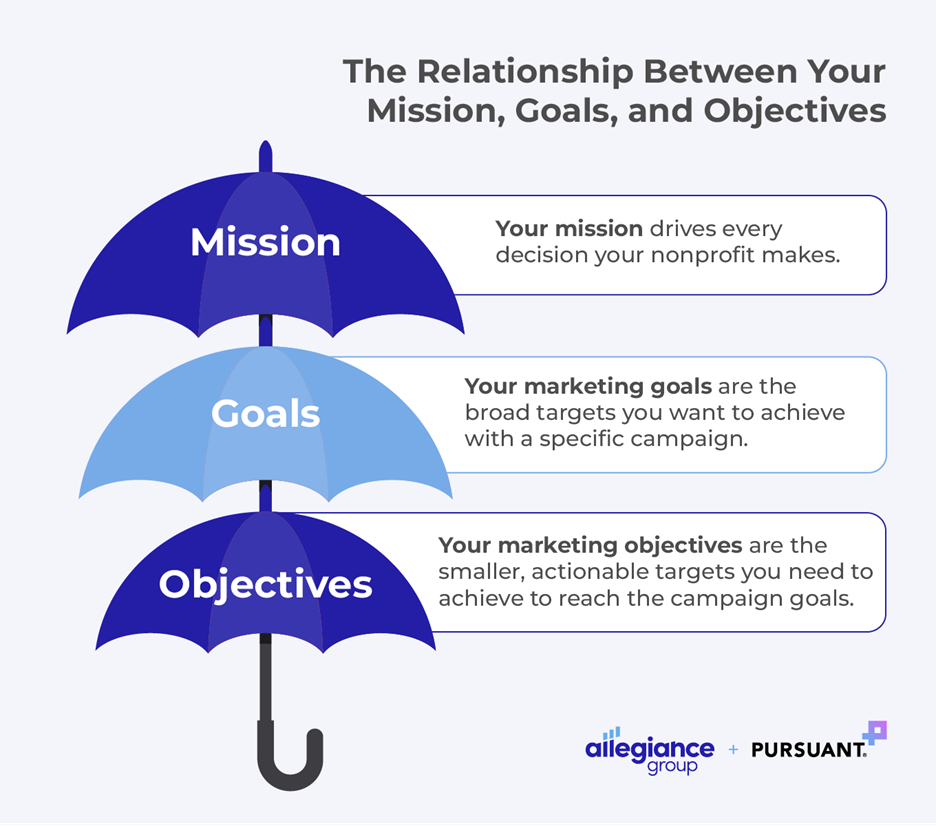
This is also a good area to elaborate more on your goals and how they will get you closer to achieving your mission. For example, acquiring new donors will help you grow your funding—money that you can then spend on helping beneficiaries. These goals are more concerned with larger, organization-wide priorities.
You’ll also need to lay out campaign objectives that correspond with each goal. Think of these as mini, measurable targets that help you inch closer to achieving your more ambitious goals. Apply the SMART method framework by making each objective specific, measurable, achievable, relevant, and time-bound.
Analysis of Target Audience
This is where you’ll insert key insights from your target audience research as well as any findings from internal audits.
Include supporter data such as:
- Demographics
- Psychographic traits (e.g., interests)
- Giving patterns
- Giving history
Feature audience personas in this section to summarize and personify your findings. For example, your conservatory might create a persona of a woman named Sage in her late twenties who works as a yoga instructor, enjoys the great outdoors, loves to travel, and engages mostly via email and at volunteer events. This persona reveals that Sage likely values face-to-face or highly personal interactions, meaning that she would respond best to a personalized event invitation.
Depending on your supporters and the campaign, you may need to create multiple audience personas to appeal to distinct segments. Returning to the conservatory example, perhaps you also need to reach an older, mostly male audience.
Market Analysis
In this section, assess the current state of the economy, regulatory environment, and other factors that could impact your campaign’s performance. For example, make note of:
- Trends among people who fit your target audience’s demographic and psychographic profile
- Other nonprofit organizations in your space and what they are doing to engage supporters
- Developments related to your cause (e.g., a new law passed thanks to your hard work)
- Economic conditions and market fluctuations
Understanding these factors can help you align your messaging with supporters’ preferences and larger social, cultural, and economic factors. For example, if you know that the economy is suffering and unemployment rates are high, you might adjust your appeals to express how much of a difference even small donations make. Or, you could rally volunteers to phone their representatives if a regressive law is about to be passed in your state.
SWOT Analysis
A SWOT analysis will help you identify your nonprofit’s strengths, weaknesses, opportunities, and threats. Strengths and weaknesses are purely internal while opportunities and threats concern external factors.
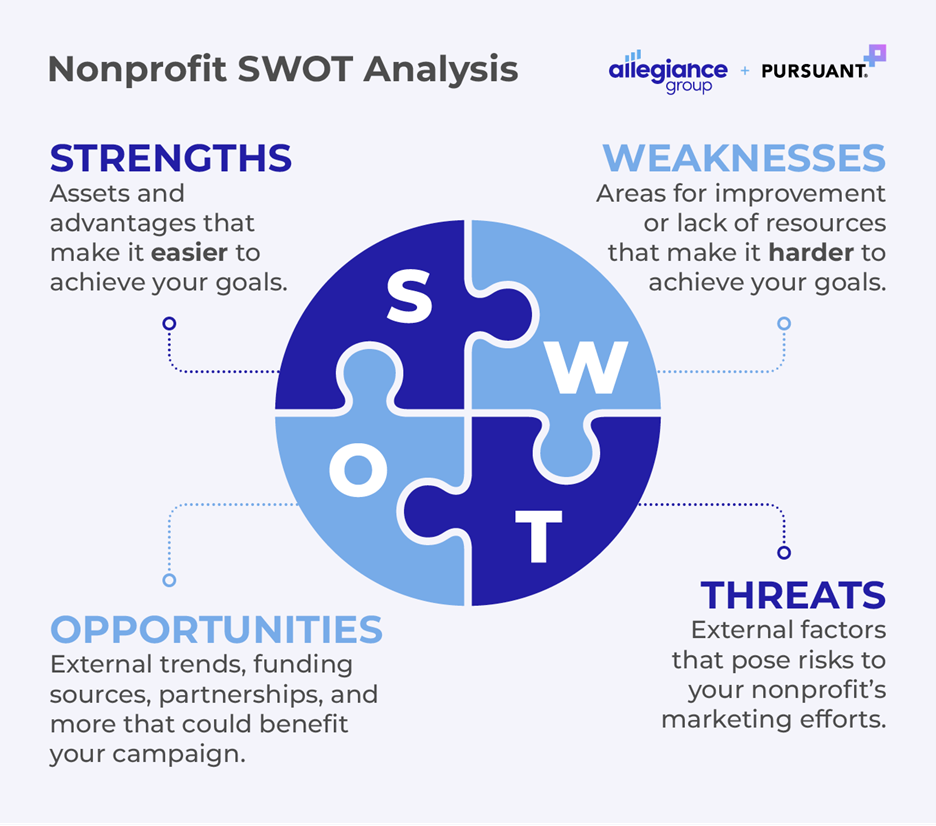
Here are some tips for completing each part of the analysis:
- Strengths: Identify any assets or advantages that set your nonprofit apart and make it easier to achieve your goals. Maybe you already have a strong, loyal base of supporters who are always willing to donate or volunteer. Or, maybe you have connections in the community that can help you spread awareness of your cause.
- Weaknesses: Critically assess your operations and identify any areas where your nonprofit lacks resources, expertise, or capacity. This might include limited funding, a small staff, outdated equipment and technology, and more. The aim is to pinpoint ways your nonprofit can improve and address barriers to achieving your goals.
- Opportunities: Are there emerging trends, changes in social attitudes, new funding sources, or potential partnerships that your nonprofit could benefit from? Identify these opportunities and determine next steps for taking advantage of them.
- Threats: Threats are external factors that pose some kind of risk to your nonprofit’s marketing efforts. These could be anything from changing donor preferences to funding cuts to damage to your reputation.
Like a market analysis, examining each of these factors gives you more information about the world around you. With this context, you can ensure none of your strengths and opportunities to grow go unused or fall through the cracks. Additionally, you’ll be prepared for any risks that could come your way.
Messaging and Positioning
Develop the core message of the campaign. This central theme should be represented in each individual component you launch, from social media posts to direct mail. Clarify how you will position this message to stand out and inspire your audience to engage.
Returning to our truth Initiative example, this campaign used the central message “Not Happy or Healthy” to bring attention to the issue (tobacco being sold in Walgreens). Activists used this phrase in hashtags on social media to spread awareness of the campaign. The simple, straightforward message communicated how young people feel about the major pharmacy selling cigarettes and the impact tobacco products have on users.
Marketing Strategies and Communication Channels
Detail the specific strategies you will use to engage your audience, making sure that they align with your audience’s preferences and interests. Make sure to consider why your audience holds these beliefs or preferences to uncover why they care about giving to your cause. For instance, someone might contribute to your healthcare fundraiser supporting cancer research because their family member was impacted by the disease. This will help you arrive at a unique value proposition that aligns with your donors’ “why.”
Then, consider segmenting your audience based on their communication preferences and developing a distinct strategy for each segment.
Your marketing strategies should also align with the focus of your campaign. If you are launching a peer-to-peer fundraising campaign, you’ll need to focus heavily on social media to engage participants and spread awareness. If you are promoting a fancy charity auction, on the other hand, you’ll want to focus more on reaching your major donors through more personal methods like phone calls and face-to-face meetings.
Based on these factors, select from marketing strategies like emotional storytelling, email marketing campaigns, content marketing, influencer marketing, and more. You’ll also need to state which communication channels you’ll be using for each segment, how you’ll maintain consistency across multiple channels, and which marketing activities you’ll implement on each one.
Budget and Resource Allocation
Determine how much your nonprofit will spend on the campaign. Remember that you’ll also need to allocate a contingency fund. Usually, this fund is five to ten percent of your overall budget, and it’s used to cover any unforeseen challenges or expenses that come up during the campaign. You might use this fund to address strategy changes, capitalize on new opportunities, and more.
During this step, you’ll also need to allocate your budget and other resources, like staff time. List each expense in the campaign, how much you plan to spend, and when you’ll need to pay for it. This way, you can rest assured that you don’t overspend on one category or run out of funding halfway through the campaign.
Campaign Timeline
Clarify when the campaign will start and end. Then draft a schedule for when you’ll implement specific marketing activities, like launching an email series or posting on social media. Include specific deadlines for each activity and indicate which team or individual is responsible for meeting those deadlines.
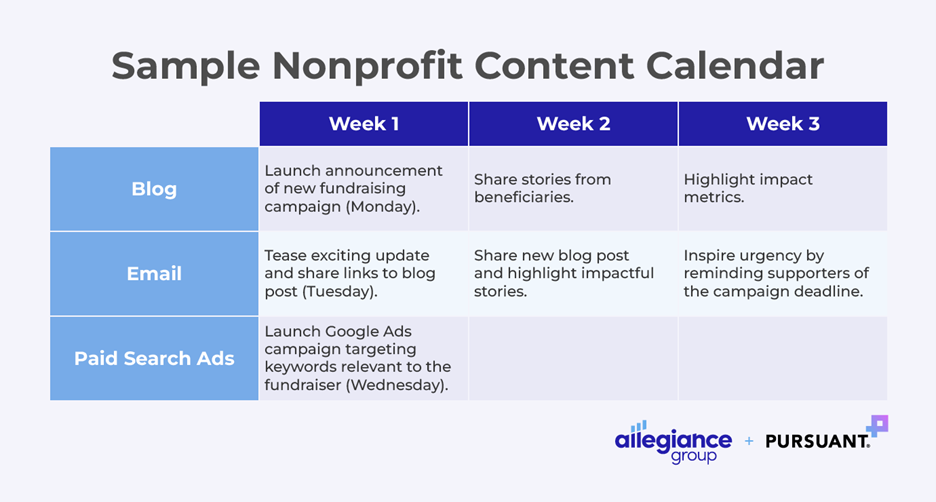
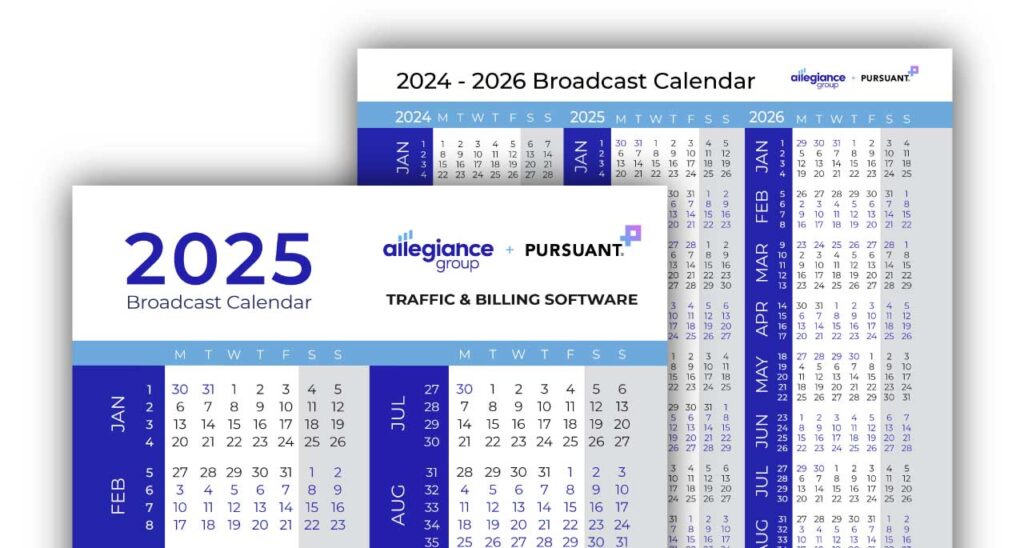
Streamline your media planning with this free print-friendly 2025 broadcast calendar (plus a 3-year 2024-2026 calendar!).
Measurement and Evaluation Guidelines
To know whether your campaign was a success, you’ll need to track metrics related to your goal. List these KPIs in this section of the marketing plan. For example, if one of your goals is to boost awareness, you might track website traffic, social media engagement, searches on Google, and new donor acquisition.
While your KPIs will depend on the campaign’s goal, it might be helpful to start with metrics like:
- Impressions: The number of times your content is displayed to users. If you reach 1,000 users and they each see the content 3 times, impressions would equal 3,000.
- Click-through rate (CTR): The percentage of users who see your marketing content and click through to your donation page (or another target landing page).
- Time on page: The amount of time a user spends on the landing page.
- Names acquired: The number of donor names your nonprofit receives through the donation form.
- Acquisition: The number of new donors you acquired as a result of the campaign.
- Conversion rate: The percentage of users who took the intended action (e.g., donating, signing up for your newsletter, signing up for volunteer opportunities, etc.).
- Email engagement metrics: These can include open rate, click-through rate, and conversion rate.
- Social media engagement metrics: Numbers like followers, likes, comments, shares, and conversions.
- Website traffic: The number of visitors your website received during a given time period.
- Cost per acquisition (CPA): The cost of acquiring each new supporter.
- Return on ad spend (ROAS): The revenue you earn per dollar spent on advertising costs. This is calculated by dividing campaign revenue by the cost of the campaign.
These metrics reveal whether you missed, hit, or exceeded your targets for the campaign. Even if you didn’t achieve your goal, you need these numbers to identify how you can improve in the future.
However, these insights are only as accurate as the data you collect. This is why tracking every interaction from every communication channel and properly attributing conversions is important. Because this process can be complicated, it’s worth working with the professionals at a nonprofit marketing agency to stay on top of your marketing data.
Get the Expertise and Experience of a Nonprofit Marketing Agency
If you think you’ll need extra support during your marketing campaign, consider drafting an RFP for a nonprofit marketing agency. A marketing agency that specializes in serving mission-driven organizations can help you build a strong, data-driven marketing plan that considers every aspect of your mission, supporters’ preferences, and market conditions. Allegiance Group + Pursuant has a team of more than 200 marketing professionals who are dedicated to helping organizations like yours do good.
We offer a comprehensive suite of services, including digital marketing, direct mail, website and app development, analytics, and more. Our strategy and planning services set your campaigns up for success by:
- Defining your top priorities, goals, and audiences before delving into strategy.
- Understanding and engaging your audience via data analysis and user research.
- Determining strengths and weaknesses with data, not assumptions.
- Involving stakeholders to implement the strategy effectively.
Using this approach, we’ll develop data-backed strategies for fundraising, digital marketing, and technology usage. These plans then guide the tactics and channels we implement to reach, engage, and inspire your supporters.
To learn more about how we can drive success for your organization, contact us today!
Wrapping Up
When it’s time to roll out a new marketing campaign, we know that you want to dive straight into strategy and content creation. But if there’s anything impactful marketing campaigns have taught us, it’s that success starts with rigorous planning and data analysis. To make sure your campaign starts out on the right track, reach out to Allegiance Group + Pursuant’s experts today!
To learn more about optimizing your marketing and fundraising campaigns, explore these guides:
- 7 of the Most Effective Fundraising Tools You Need to Try. Level up your fundraisers with these top tools that streamline the process for you and your donors.
- How to Get Donations for a Fundraiser: 10 Best Practices. Check out our top strategies for engaging donors and motivating them to give to your cause.
- The Foundation of Successful Fundraising: Defining Your Nonprofit’s Unique Value Proposition. What makes your nonprofit stand out? Learn more about unique value propositions and how to define yours